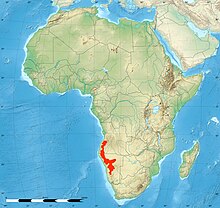Python anchietae
| Python anchietae | |
|---|---|

| |
| Scientific classification | |
| Kingdom: | Animalia |
| Phylum: | Chordata |
| Class: | Reptilia |
| Order: | Squamata |
| Suborder: | Serpentes |
| Family: | Pythonidae |
| Genus: | Python |
| Species: | P. anchietae
|
| Binomial name | |
| Python anchietae Bocage, 1887
| |
| Synonyms[2] | |
| |
Python anchietae (common names: Angolan python, Anchieta's dwarf python)[3] is a nonvenomous python species endemic to southern Africa. According to Donald George Broadley (1990), this species is most closely related to the ball python (P. regius) of western Africa,[3] and no subspecies are currently recognized.[4] It is named after the Portuguese naturalist and explorer José Alberto de Oliveira Anchieta.[5]
Description[]
Python anchietae may grow up to 183 cm (6 ft) in total length (including tail). The color pattern is a reddish-brown to brown to almost black ground, overlaid with irregular white or cream-colored bands and spots. The belly is yellowish. A rare species seldom seen in the wild or in captivity, it is the only python to have "bead-like" head scales.[3] It has heat sensitive pits, five on each side of the head, on the upper lip. The smooth dorsal scales are arranged in 57-61 rows.[6]


Distribution and habitat[]
Python anchietae is found in Africa in southern Angola and northern Namibia. The type locality given is "Catumbella [Catumbela]" near Lobito, Angola.[2][4] Habitats are rocky outcrops or areas strewn with rocks in open brush or grassland.[3] Diurnal, they shelter in small caves, overhangs and crevices.
Behaviour and biology[]
Python anchietae exhibits similar temperament to its closest cousin, the ball python. It hisses, but this is mostly bluff.[3] Diet consists of small mammals and birds.[3] P. anchietae is oviparous, with small clutches of four to five eggs being produced at a time. It is not known whether the females "incubate" their eggs as is typical for the members of this family. Hatchlings are 43–46 cm (17-18 inches) in length.[3]
Captivity[]
Python anchietae is rare in captivity due to the long civil war in Angola. Although the war is over, the fields and forests are covered with land mines, and few dare to risk catching them.[citation needed]
References[]
- ^ Baptista, N.; Becker, F.; Conradie, W.; Bauer, A.M. & Ceríaco, L.M.P. (2021). "Python anchietae". IUCN Red List of Threatened Species. 2021: e.T177539A120594491. doi:10.2305/IUCN.UK.2021-2.RLTS.T177539A120594491.en. Retrieved 19 November 2021.
- ^ a b McDiarmid, R.W.; Campbell, J.A.; Touré, T.A. (1999). Snake Species of the World: A Taxonomic and Geographic Reference. Vol. 1. Washington, District of Columbia: Herpetologists' League. ISBN 1-893777-01-4.
- ^ a b c d e f g Mehrtens JM (1987). Living Snakes of the World in Color. New York: Sterling Publishers. 480 pp. ISBN 0-8069-6460-X.
- ^ a b Python anchietae at the Reptarium.cz Reptile Database. Accessed 25 September 2020.
- ^ Beolens, Bo; Watkins, Michael; Grayson, Michael (2011). The Eponym Dictionary of Reptiles. Baltimore: Johns Hopkins University Press. xiii + 296 pp. ISBN 978-1-4214-0135-5. (Python anchietae, p. 8).
- ^ Branch, Bill (2004). Field Guide to Snakes and other Reptiles of Southern Africa. Third Revised edition, Second Impression. Sanibel Island, Florida: Ralph Curtis Books. 399 pp. (Python anchietae, p. 59 + Plate 17).
| Wikimedia Commons has media related to Python anchietae. |
Further reading[]
- Bocage JVB (1887). "Sur un Python nouveau d'Afrique ". Jornal de sciencias mathematicas physicas e naturaes, Lisboa [12] (46): 87-88. (Python anchietae, new species). (in French).
- IUCN Red List least concern species
- Python (genus)
- Snakes of Africa
- Reptiles of Angola
- Reptiles of Namibia
- Reptiles described in 1887
- Taxa named by José Vicente Barbosa du Bocage
